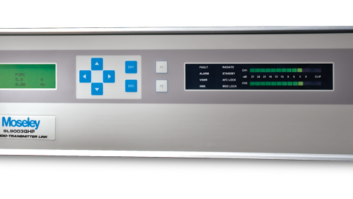Transmitter overload is something we dread. Although a day spent on transmitters may overload your brain, it’s not a bad thing.
I had the pleasure of hosting the fourth annual Transmitter Workshop at this year’s NAB Radio Show. The focus on transmitters and maintenance brought good discussions and some really good maintenance tips.
We’ll start with some of the maintenance tips from our manufacturers’ panel. Wendell Lonergan, project leader for Nautel, suggested annual cleaning of the plug blades on the Cinch-Jones connectors used on its Ampfet 1—10 modules with Caig Labs’ DeoxIT. Information on the Caig product line can be found at www.caig.com
A film can develop on the plug terminals and the DeoxIT does the best job in cleaning off that film.
Lonergan also recommended an annual inspection of the hardware used in the transmitters – especially in the power supply and RF filter. The hardware should be tightened, including bolts and nuts used with capacitors, inductors and leads. While you are inspecting the hardware, check for any discoloration of hardware or leads, caused by heating.
Nautel replaced its aluminum module fan filters with a two-part plastic filter. The reason was quite interesting. It seems that as flies or bugs were caught in the aluminum filter, their acidic body juices ate away at the aluminum as the bodies decomposed, eventually destroying the filter. The two-piece plastic filter prevents this from occurring.
Another useful maintenance test was to reverse the FWD/REV power leads on the ND-10 transmitter, then bring the transmitter power up slowly. This checks the VSWR protection circuit, a test that should be performed annually.
. . .
(click thumbnail)Fig. 1:Inspect tube socket finger stock for broken or bent fingers
Dave Agnew is the FM products application engineer for Harris. For owners of the Harris MS-15 or MX-15 exciter, Agnew suggested inspecting the U-1 regulator (on the MS-15) or the Q-1 regulator (on the MX-15) if the fan fails. This component may fail when the fan dies.
For the Harris low-power tube FM transmitters (3 to 10 kW), routine maintenance should include checking the tightness of the cavity hardware. If a PA screen or plate overload occurs, check for a dirty arc gap, a power supply component failure or a bad PA tube.
When replacing the tube in any transmitter, ensure that the tube is seated properly. Check the unit to ensure the screen contact assembly covers the screen ring.
By the way, while the tube is out, check the finger stock in the tube socket. If more than three or four spring fingers are missing on any one ring, the efficiency of the transmitter can be affected. Remember not to twist tubes when inserting them into sockets; instead, press it into place – rocking slightly if necessary but never twisting. The twisting action will break or bend the contact fingers in the socket.
Agnew offered an interesting way to clean plated relay contacts, upon which a file would scrape away the plating metal. Use a piece of brown paper bag, soaked in contact cleaner. The roughness of the paper bag combined with the cleaning power of the contact cleaner thoroughly cleans relay contacts without disturbing the plating.
The issue of the cost of replacement semiconductors for transmitters was also discussed.
Agnew told of customers who bought replacement FETs from a surplus warehouse, only to have them fail or not work at all. Transmitter manufacturers design equipment with specific operating specifications.
Surplus, or “equivalent” devices may not meet the same operating specifications – even though pieces are marked by the same part number. What appears as a good deal from an outside supplier may just be a waste of your money.

. . .
(click thumbnail)Fig. 2:Lights warn that AC voltage is still present on this high-voltage cabinet
Martin Cooper of Transcom, a buyer and reseller of used transmitters, offered some tips on getting the most out of ol’ reliable.
First, any transmitter built prior to 1975 has a limited value in today’s market. A 10-year-old transmitter may return 10 percent or more of its new value, depending on its condition. A 20-year-old transmitter may return only 5 percent.
Cooper warned that a station cannot obviate or transfer its responsibility with regard to PCB oil-filled devices (capacitors and transformers) found in many older transmitters. His advice: Get your local power company to remove and dispose of them – don’t sell a transmitter to anyone with PCB capacitors or transformers inside.
What’s the biggest factor that determines resale cost? Cooper says adequate maintenance, cleanliness and properly documented changes top the list. Surprisingly, an accurate tech manual and schematics figure into the overall value – as do spare parts.

. . .
(click thumbnail)Fig. 3:A heavy-duty monitor stand that raises the monitor to eye level, if neededA discussion of the hazards of working on transmitters reminded me of this neat add-on feature that Deborah Proctor’s staff installed at WCPE(FM) in Wake Forest, N.C.
Fig. 2 shows the red glow of two lamps installed in the transmitter high-voltage vault. The reason for this is that killing the front-panel transmitter breakers does not remove voltage from the high voltage power supply vault.
The red lights warn that AC is still present – the two lights in parallel guard against one light burning out.

. . .
Looking for a pretty cool monitor stand? One that will support even heavy monitors?
Dick Schumeyer of Harris-Pacific sold the pedestal/stand seen in Fig. 3 to Chris Kelly at the Salisbury, Md., Clear Channel outlet.
The stand will permit the monitor to be placed at copy board level, or raised, as in the photo, so that it’s at eye level with the talent.
Submissions for this column are encouraged and qualify for SBE recertification credit. Fax your submission to (703) 323-8044, or send e-mail to [email protected]











